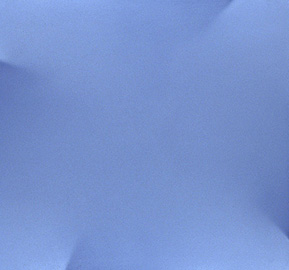Contemporary Visual Arts |
|
|
Issue 22 Spring 1999 |
|
|
|
|
| Gwen Hardie, Open-ended (1), 1998 oil on canvas, 140×150 cm Courtesy Beaux Arts, London | |
Gwen Hardie |
|
|
by Sandra Lee |
| In 1995, after more than a decade of uncompromising figuration, Gwen Hardie’ obsessiosn with the material image of womanhood began to give way to a diffuse set of configurations dispersed in a more amorphous space. The paintings shown recently at Beaux Arts, London, take this disappearing act one stage further. Gone are any overt allusions to the female body. Gone, too, are the heavier worked surfaces of earlier years. In their place are vacated arenas constructed from thin monochromatic washes. Yet the scale and vacuity implicit in this reading is immediately undermined by the inclusion of more concrete forms. These trompe-l’oeil devices return us to the actual scale of the canvas-as-object. Implying that the physical material of the picture plane has been penetrated from behind, they remind us how thin and malleable this membrane actually is. At the same time these simple linear forms reiterate the rectangle of the picture plane. However, this shift to a more formal content and reading seems to have little connection with Hardie’s earlier work.are we to make of this shift? In the first place the artist appears to have evolved with the climate of the nineties, against which the overt feminist figuration of the previous decade can seem trite and passe. This passage has been a gradual journey from full-figuration through more abstracted detail to what might now be read as the interstices – the spaces between bone and sinew. Meanwhile the thinner washes of paint have more in common with fashionably contemporary painters such as Paul Winstanley, whose studio is adjacent to Hardie’s own. So is this simply a case of an artist reinventing her practice to appear more ‘of the moment’? | Hardie’s evolution to date has been fickle. At times she has gone back to revisit earlier stages of her own development, while at others she has taken discontinuous leaps forward. All of which mitigates in her favour, for this is surely not the action of an opportunist. It arises, I suspect, out of a chaotic working process, for while the artist may be consistent across paintings within an individual series she is clearly less programmatic in the long term. Therefore, to project the current series as being the culmination of a long gestation is both illuminating and misleading in equal measure, for while it is possible to construct a linear development from Hardie’s work there is also the element of chance. It is this element which at times has allowed her to revisit earlier stages and at others to integrate her own practice with that of her peers.This said, in the final analysis Hardie resists easy comparison with others of her generation. Despite obvious comparisons with the monochrome painting of Clem Crosby, Jason Martin et at, the niche Hardie carves Out for herself is her own. The demarcation of this private space rests in part on our awareness of how these seeming ‘abstracts’ remain indebted to figuration and in part on their ability to hint at the artist’s involvement in Eastern art and religion. As in the work of Mark Tobey, there is a slight distance that sets Hardie’s painting apart from the more materialist concerns of other Western artists, especially those who have dominated in London of late. But just as Tobey drew inspiration from the Japanese ceramicist Shoji Hamada, and in so doing dissociated himself from the more macho stance of contemporaries like Pollock, so there is a danger that Hardie will be seduced away from her previously robust project by the more delicate and decorative aspects of the East.
Gwen Hardie was at Beaux Arts, London, 10 February -6 March |

